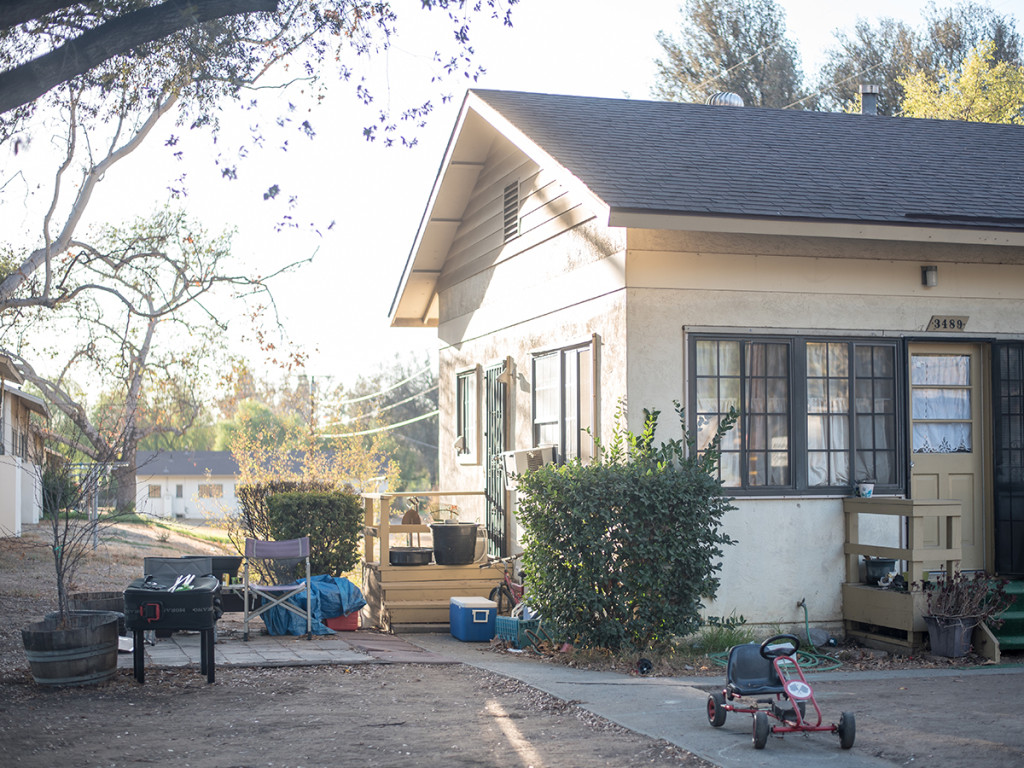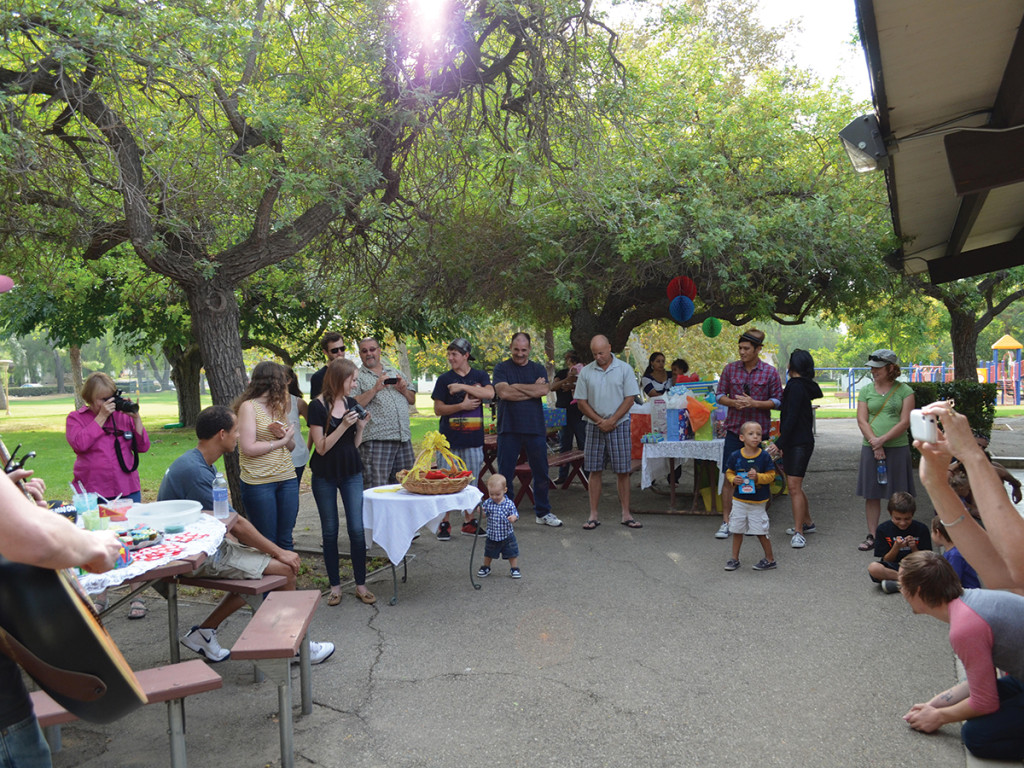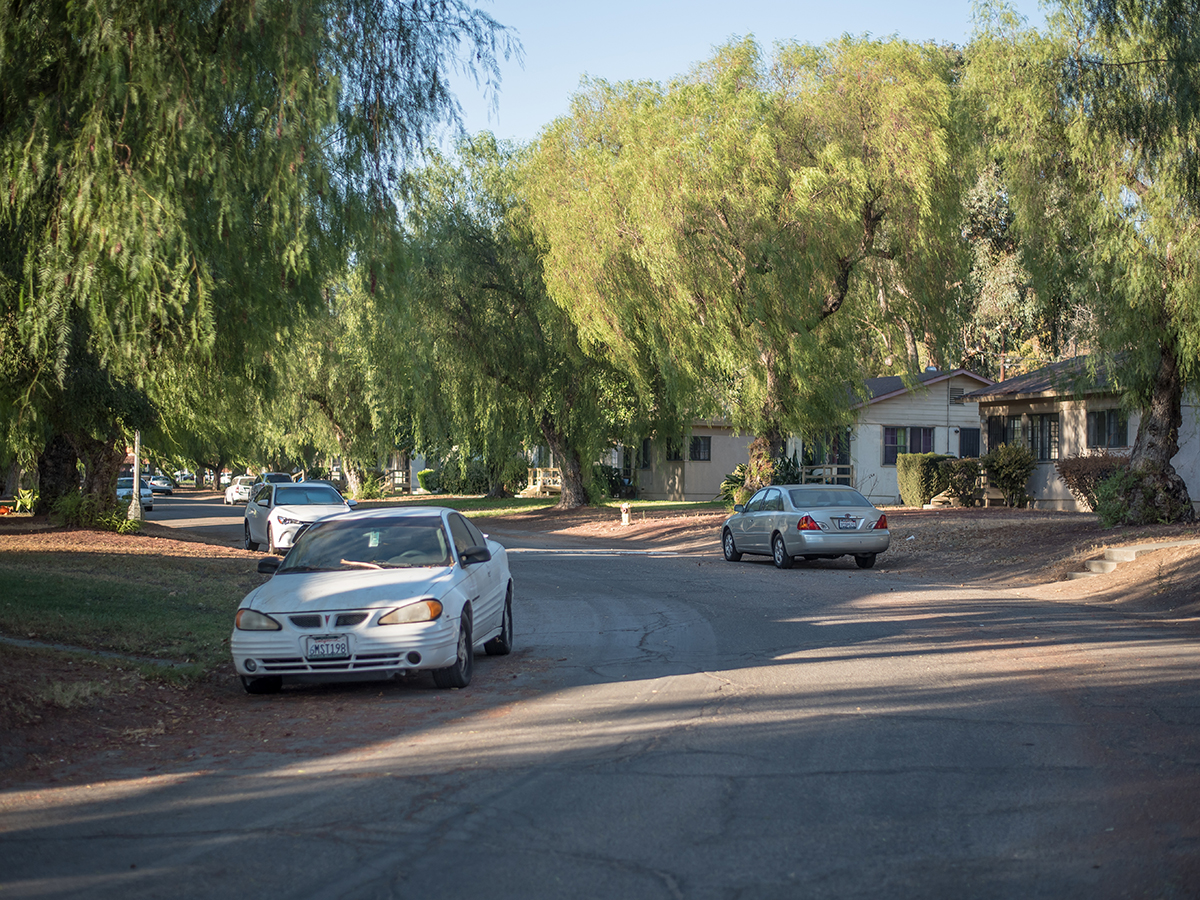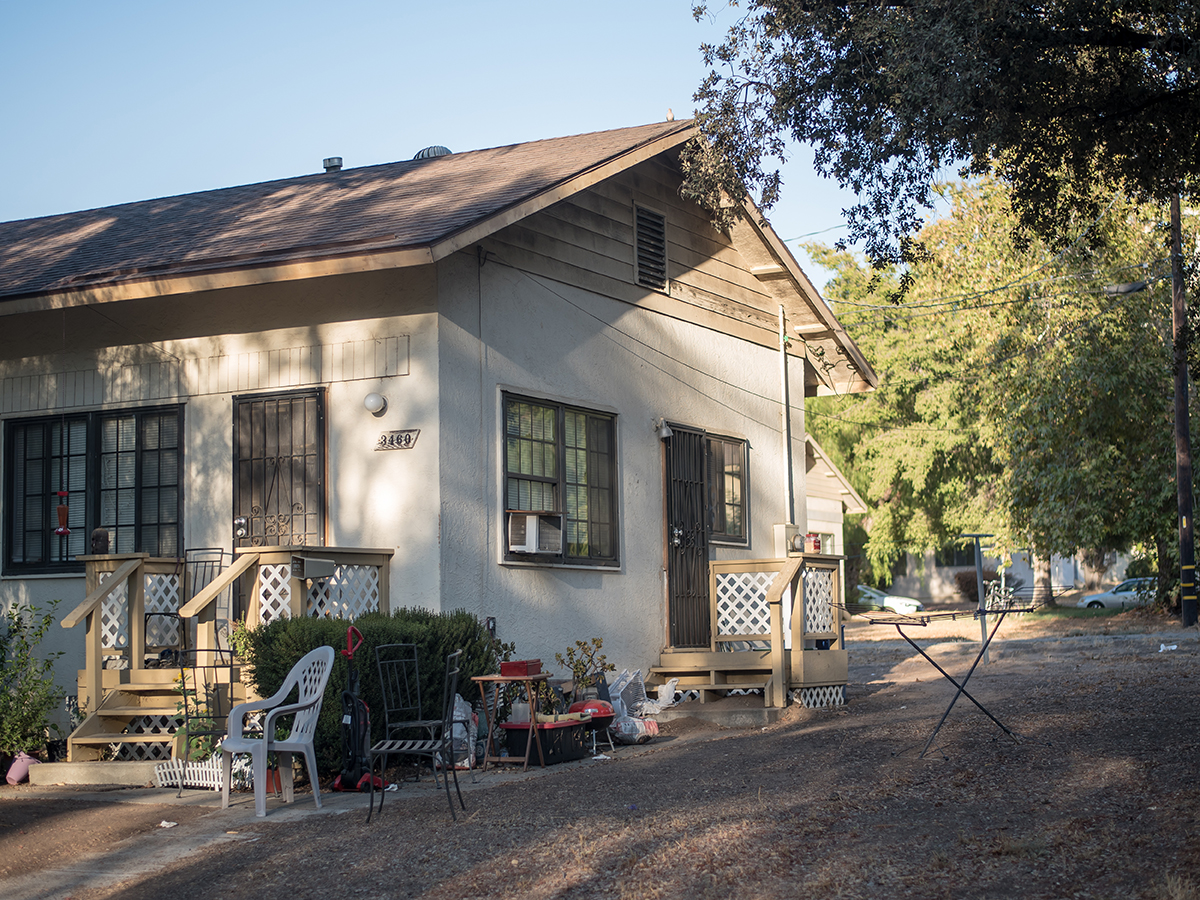
It is a calm, late Saturday afternoon on the tail end of summer and Canyon Crest Family Student Housing doesn’t feel like a community on the verge of extinction. Instead, playing children jump through literal hoops on the area’s playground, two brothers snicker as they chase a ball down the road, parents stand in the yard tacking newly washed linens on clotheslines and family dinners hosted outside are consumed by laughs and engaging conversation.
If the scene at all feels relic, that’s because UC Riverside’s family student housing is.
Established in 1940 as housing for families of military officers to what was then known as the March Army Air Base, the 55-acre-wide community stands today as an aberration in an infrastructural era overswept by compactness and verticality. Though, since being acquired by UCR in 1955, family housing’s legacy has been better defined by its rare offering of affordable rent, outstanding community and a substantial support system for students and student families.
And yet, that legacy is nearing its end. On May 3, 2016, after an almost two year-long planning process, UCR Chancellor Kim Wilcox introduced his Campus Physical Master Plan to the public. The plan is Wilcox’s comprehensive vision for the future of UCR, equipped with two new multidisciplinary research buildings, a STEM center, an outpatient pavilion and an on-campus site for the California Air Resources Board. Also included is the forthcoming development of the Campus Event Complex (set for July 2017), a structure featuring a new event center and a myriad of businesses all lying smack in the middle of what will no longer be family student housing.
In a sense, the dichotomy between the tranquil atmosphere it portrays and the life-changing demolition that looms is a testament to family housing’s fortuitous nature — a dreamlike contrast to a nightmareous reality that has the community on its absolute last stand. Here, we share the voices of some of those affected by this approaching change and the group of administrators executing it.
The Former Resident
Riverside native Heather Andrews-Horton is 30 and living in a quiet, two-bedroom home just along the outskirts of downtown Riverside with her husband, Nathan Horton, and two sons, Elliott and Lennon. The home, which they purchased for a mere $260,000 in January of last year, represents their first owned property as a family.
On the surface, they lucked out. Not only did they purchase the home significantly below market value but it is equipped with bountiful garage space, a roomy backyard and within walking distance of Mountain View Park. Yet, for them, the amenities pale in comparison to the communal atmosphere of UCR’s family housing.
Technically, Andrews-Horton began living in UCR family housing in fall of 2012, when she started pursuit of her Master’s degree in Public History. But her ties to the community reach as far back as 1984, the year her uncle began renting there as he earned his Ph.D. in History.
“It is kind of a trend in my family to go to (Riverside Community College) and then transfer to UCR,” says Andrews-Horton. This rings true. Outside of herself and her uncle, Andrews-Horton’s grandfather spent 40 years as an English professor at RCC and she currently has two cousins attending UCR to pursue their Ph.D.’s in History and Biology, respectively.
Though, what drove her back to family housing in 2012 went beyond familial lineage and rather the solace she found in the neighborhood’s unique combination of affordability and community. “That was the main reason we chose UCR,” she professes, “so that we could live in a neighborhood and our kid could feel like he had a house and we (would) not have to put him in daycare because the rent was so cheap.”
Due to family housing’s cheap rent, Andrews-Horton was able to attend graduate school while her husband stayed home with their children.
“People don’t get to feel privileged very often when you’re a family trying to get by in graduate school or just going to school and having kids,” says Andrews-Horton. “You take for granted that it’s going to be a struggle and living in family housing you got to feel like you (could) do both. You got to have an address that wasn’t an apartment and a lawn and a playground … You didn’t feel like you were taking anything away from your children to go to school and that’s unique.”

The appreciation for the ease of life that family housing offers student parents is a sentiment shared by David Chavez, a first-generation Ph.D. student in History at UCR and former family housing resident. Chavez began living in family housing in August of 2013 before moving into his parents’ home in Pasadena alongside his wife and daughter in July of 2015.
When asked what he misses about living in family housing, Chavez quips “having our own place,” before giving the question more thought. “I definitely miss the camaraderie we had with our neighbors,” he says. “I miss being able to take my daughter to the playground and being able to have those interactions with her.”
The Current Resident
“I was homeless before I moved here.”
These are a few of the first words I hear from Denise Jackson, 36, upon sitting inside her home. Prior to moving into family housing in 2013, Jackson spent three years shifting between homeless centers and transitional housing and, in between that time, also gave birth to her son who is now five years of age.
When asked what family housing has provided her, Jackson immediately offers, “Security,” before fighting back tears. “A safe home for my family, support that I needed. It was my structure to get where I needed to be and to be close to school and (help) push myself to get the degree that I’m earning right now.”
For the past three years, Jackson and her son have felt fortunate to simply say they have a home, and while that won’t change with their next transition, the imminent move brings forth an entirely new set of inconveniences.
“We found a place around the same cost of those apartments and it’s a four-bedroom, two-bathroom,” says Jackson, who officially moved out on Oct. 3. The caveat is that it’s in San Bernardino, taking her further away from campus and forcing her five-year-old to change schools.
“Those apartments” Jackson references are UCR’s Oban apartments, a complex currently used to house undergraduate students and the planned site for UCR family student housing in July 2017. The plan proposed by administration is for current family housing residents to move into Oban at a fixed rate occurring over three years, starting at $935 per month in their first year to upwards of $1,300 by year three. Even with this apparent compromise, Oban’s lack of size variability (its biggest floor plan is a two-bedroom, two-bath) and high cost fail to accommodate low-income student families such as Jackson’s.
“I have a family now. I have a boyfriend and he has kids so, we’re moving together,” she says. “I can’t live in a two-bedroom, that’s just not feasible for us and the price is not feasible for us.”
Though not ideal, some residents, such as fourth-year Ph.D. student Shawn Ragan, are opting to move into Oban if only for the first year, when rent will be at its lowest.
“I think I’m at a place now where I can finish my degree before rent (gets) too high,” says Ragan, “but that doesn’t help (newer residents) and if I were earlier in my program … I probably couldn’t do it.”
Ragan is Jackson’s direct neighbor, living with three children in a three-bedroom house just near the community’s Florida St. entrance. He, along with his ex-wife and kids, made the move from Idaho to Riverside in August of 2012 and he commends family housing’s communal atmosphere for not only attracting him to UCR but helping his family immediately feel at ease.
“If it were not for family housing we wouldn’t be here,” he attests. “Everyone here is student families, so there is a common hardship and shared support network.”
Ragan shares stories of family movie nights held with a large projector in his backyard where other residents of the community would walk by to casually join in — one of many examples of the charitable atmosphere that Ragan is pessimistic can be recreated elsewhere.
“I think that’s what gets lost in apartment housing,” laments Ragan, “that sense of community and ability to build connections.”
Beyond the change in atmosphere, Ragan’s potential move to Oban greets him with a more fundamental question: How can it be afforded?
Currently, Ragan is paying $775 monthly for rent and worries about his ability to manage the steep increases expected over several years at Oban, if unable to complete his degree in the next year. The concern is legitimate. Paying rent at the eventual monthly rate of $1,335 amounts to $16,020 annually. Currently, his teaching assistant’s salary amounts to $19,279 over the course of a year, leaving an additional $3,000 a year to cover expenses outside of rent.
For Ragan that includes paying utilities, taxes, union dues and additional student fees all while supporting two sons headed to college and providing for he and his daughter’s basic needs.
This is a fundamental conundrum Ragan, who also serves as Vice President of Academic Affairs for the Graduate Student Association, sees as all-too-common for many current residents and he expects the eventual future of family housing to be bleak.

“This is the gentrification of UCR family housing and I expect it will eventually end family housing altogether,” laments Ragan. “Simply, a lot of these families won’t be able to afford to live (in Oban) and then they’re just going to turn it back into undergraduate apartments. Sadly.”
UCR Ph.D. student Arturo Nevares currently lives in in family housing’s two-bedroom setup with his wife of four years, Diane, and their two-year old daughter, Quetzali. As we talk, he recalls the moment he received the email confirming their looming displacement.
“It was kind of infuriating, really, that we weren’t a part of the discussions to demolish housing,” Nevares reflects. “There had been meetings but we weren’t informed about (them) until after the fact.”
The process after being informed of family housing’s demolition consisted of additional meetings led by UCR administrators with the intention to inform residents on their options moving forward. However, Nevares felt these were conducted with what he deems a “top-down approach.”
“From being there … it seemed like they weren’t really looking for our input, it was more like damage control,” he admits. “I think going into the meetings, many (residents) thought we were going to have a voice, hopefully leading them to reassess what we’ve been forced into. But it wasn’t like that.”
On The Waiting List
Vinicius Canale is an international student from Brazil in his second year as a UCR post-grad and has yet to truly settle in.
In July of 2015, Canale applied for family housing after receiving multiple referrals from his fellow labmates, who touted it as an affordable option.
At the time, Canale was well aware of the usual nine to 14-month month wait period. Yet now, just over 14 months and a couple temporary homes later, Canale and his wife are paying $1,100 a month to live in his brother-in-law’s home in Menifee — another temporary setup until his brother-in-law returns from military service in Arizona next year.
(Family Housing) was my structure to get where I needed to be and to be close to school and (help) push myself to get the degree that I’m earning right now.”
-Denise Jackson
What happened? Well, in short, word-of-mouth spread. After sharing the news of his successful application process with peers, Canale began hearing murmurs that a demolition of family housing could be imminent. In reaction, Canale sent multiple emails to the family housing facility and UCR administration, yet was still unable to receive a clear response.
“I was trying to find out family housing’s future and they never really gave me an answer … I was only told my position on the waiting list and that sometimes it takes longer than what’s predicted.”
It wasn’t until Canale arrived at the facility two months later, demanding for straight-forward answers, that he got clarity on the situation. “I said, ‘I have been hearing from many different people that there is a plan to demolish family housing, is this true?’,” recalls Canale, “and they said, ‘yes, that is true.’” This was in October of 2015, seven months before the Chancellor’s official announcement of his Physical Master Plan in May 2016.
As of now, Canale’s plans after his brother-in-law’s eventual return are vague. But, considering they’ve stopped filling vacancies in family housing, he is defaulted to scouring for an affordable option.
Oban will certainly not be one of those. Currently, Canale is living on a $1,300 monthly stipend provided through his fellowship from Brazil. And, as a non-resident of family housing, Canale is not eligible for the gradual pay increase, meaning renting at Oban next year would cost him $1,335 per month — $35 more than his current stipend provides.
“It is not a feasible option for me,” attests Canale before giving the current conditions more thought. “As an account, who are the people living in UCR family housing right now? The majority of them are graduate students and post-doc students and they don’t have a job. I don’t have a job and 100 percent of my time is focused on my studies. … So it’s pretty much to afford a $1,300 lease for Oban, it would be my whole stipend.”
Now, two years into his degree, Canale is essentially stuck in his current situation, but does admit some regret in his decision to attend UCR.
“I can tell you right now, if I were in this situation … married while deciding where to study, I would not look to UCR. I would be at a different campus.”
The Administration
Within UCR administration, their reasoning for the change is, if nothing else, consistent.
Their logic can best be summed up by how Chancellor Wilcox described family housing facilities during his Physical Master Plan presentation in May, deeming them “well past their prime,” making for a “very hard time keeping them habitable.”
Essentially, the collective view from administration is that to maintain and renovate the current facilities is a more costly method than simply adding new, modern facilities altogether. “The infrastructure (in family housing) is a big issue,” asserts Vice Chancellor of Auxiliary Services Andy Plumley, “Sewer lines are going, water lines are going and it just wouldn’t feel like a community anymore as you’re dwindling it down.” This all rings true and appears logical, though the larger question still persists: If this isn’t the future of family housing, then what exactly does its future look like?
For Wilcox, it’s clear. “We need to get bigger,” he declares and, really, it’s hard to disagree. The size of this year’s incoming class is an all-time high for UCR and the student body will continue to grow as the school aims to meet the UC Committees on Finance and Long-Range Planning’s Three-Year Financial Sustainability Plan, intended to increase freshman and transfer enrollment by 10,000 throughout UC campuses over the next three years.
It is also clear that Wilcox is looking for growth beyond the next three years, not only has he been adamant in his goal of achieving 27,000 students by 2020 but has gone so far as suggesting he “envision(s) the campus somewhere in the future having 40 to 50,000 students,” at the UC Regents meeting on Sept. 15.
And as for where family housing falls into this long-term vision, many worry it simply doesn’t. While many faculty and students commend Wilcox’s ambition for growth, many view the choice to potentially phase out low-income student families as an example of a larger issue: The administrators’ decision-making threatens the goal of maintaining the diverse and inclusive campus that UCR has historically prided itself upon.
Nevertheless, Vice Chancellor of Student Affairs James Sandoval emphasizes that “affordability is key in making sure that we have the least expensive (housing) options available in the short-term,” continuing that, “In the long term, family housing is a high priority and building affordable family housing is part of that.”
Though still, there is some ambiguity as to what “affordability” actually means in the broader context of the administrative perspective. As it stands, the expected prices at Oban are unaffordable for the traditionally low-income student families who opt to reside in family housing and, when asked if the costs of future family housing will be lower than those projections, Wilcox admits they’d likely be “about the same.”
Stepping away from affordability, UCR administration is unabashedly confident that the communal atmosphere of family housing can be recreated at Oban apartments and in other future facilities.
Family housing and its community are wholly unique though, something Plumley acknowledges, admitting any rendition will never be “exactly the same,” but he stresses they are “trying to maintain a good community and we believe Oban could deliver that.”

In speaking with families, it is clear that plenty of the value in the community lies in the area’s intangibles —- the open green space allowing children to roam freely and safely, the nostalgia of the playground area and the benefits that come with raising a child in direct proximity of a university campus.
With Oban, the proximity remains, but other than the planned building of a fence to border the space between the complex and major streets and a small playground set to replace Oban’s volleyball court, there are no other developments in place that address recreating the atmosphere.
Plumley, though, remains confident it can work.
“I’ve been working with residents a long time,” says Plumley. “You can fall in love with the building, fall in love with the community and all that, but it’s really the people. So long as there is good interaction with the people, it’s all good.”
What’s Next?
Going forward, the displacement of students and families is imminent as UCR paves way for modern infrastructure more adaptable for a campus with an increasingly large student body. While some administrators admit cognizance of the sentimentality of family housing, the theory that Wilcox and Vice Chancellor of Business and Administrative Services Ron Coley stress the importance of goes as follows: “You can’t move forward if you stay in the same space.”
Though, in that same vein, this space has allowed for thousands of low-income students and student parents to take significant steps forward in academia and their personal lives, providing them an opportunity to attend school and raise and enjoy their families without the financial stresses which often accompany those conditions.
In the end, the playing, the snickering, the conversations over dinner will continue, only now with the caveat that it will soon be the last time. And yet, family housing and the impenetrable community it continually manifests will stand; iconoclastic in an increasingly detached society and seemingly prepared to disappear with a reserved nobility — just as it long existed.








